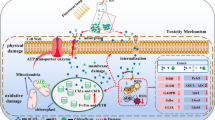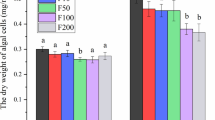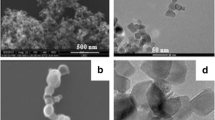Abstract
Extensive application of nanomaterials enlarges its concentrations in the aquatic environments and poses a threat to algae. This study comprehensively analyzed the physiological and transcriptional responses of Chlorella sp. after being exposed to chromium (III) oxide nanoparticles (nCr2O3). The nCr2O3 at 0–100 mg/L presented adverse effects on cell growth (96 h EC50 = 16.3 mg/L), decreasing the photosynthetic pigment concentrations and photosynthetic activity. Moreover, more extracellular polymeric substances (EPS), especially polysaccharides in soluble EPS, were produced in algae cell, which mitigated the damage of nCr2O3 to cells. However, with the increase of nCr2O3 doses, the EPS protective responses were exhausted, accompanied by toxicity in the form of organelle damage and metabolic disturbance. The enhanced acute toxicity was closely related to the physical contact of nCr2O3 with cells, oxidative stress, and genotoxicity. Firstly, large amounts of nCr2O3 aggregated around and were attached to cells, causing physical damage. Then, the intracellular reactive oxygen species and malondialdehyde levels were significantly increased that led to lipid peroxidation, especially at 50–100 mg/L nCr2O3. Finally, the transcriptomic analysis further revealed that the transcription of ribosome, glutamine, and thiamine metabolism-related genes were impaired under 20 mg/L nCr2O3, suggesting nCr2O3 inhibited algal cell growth through metabolism, cell defense, and repair, etc.
Graphical Abstract







Similar content being viewed by others
Data availability
All data generated or analyzed during this study are included in this article.
References
Ahmed T, Noman M, Manzoor N, Ali S, Rizwan M, Ijaz M, Allemailem KS, BinShaya AS, Alhumaydhi FA, Li B (2021) Recent advances in nanoparticles associated ecological harms and their biodegradation: global environmental safety from nano-invaders. J Environ Chem Eng 9(5):106093
Alarifi S, Ali D, Alkahtani S (2016) Mechanistic investigation of toxicity of chromium oxide nanoparticles in murine fibrosarcoma cells. Int J Nanomed 11:1253–1259
Aquino SF, Stuckey DC (2004) Soluble microbial products formation in anaerobic chemostats in the presence of toxic compounds. Water Res 38(2):255–266
Baharlooeian M, Kerdgari M, Shimada Y (2021) Ecotoxicological effects of TiO2 nanoparticulates and bulk Ti on microalgae Chaetoceros muelleri. Environ Technol Inno 23:101720
Chen YD, Bergendahl J (2021) Identification and quantification of a wide variety of inorganic nanoparticles in municipal wastewater. Environ Sci Pollut R 25(4):0000634
Chen B, Li F, Liu N, Ge F, **ao HX, Yang YX (2015) Role of extracellular polymeric substances from Chlorella vulgaris in the removal of ammonium and orthophosphate under the stress of cadmium. Bioresour Technol 190:299–306
Da Costa CH, Perreault F, Oukarroum A, Melegari SP, Popovic R, Matias WG (2016) Effect of chromium oxide (III) nanoparticles on the production of reactive oxygen species and photosystem II activity in the green alga Chlamydomonas reinhardtii. Sci Total Environ 565:951–960
Fan GD, Zhou JJ, Zheng XM, Chen W (2018) Growth inhibition of microcystis aeruginosa by copper-based MOFs: performance and physiological effect on algal cells. Appl Organomet Chem 32:12
Fang F, Lu WT, Shan Q, Cao JS (2014) Characteristics of extracellular polymeric substances of phototrophic biofilms at different aquatic habitats. Carbohyd Polym 106:1–6
Fujii K, Nakashima H, Hashidzume Y (2010) Isolation of folate-producing microalgae, from oligotrophic ponds in Yamaguchi. Japan J Appl Microbiol 108(4):1421–1429
Gao X, Deng R, Lin DH (2020) Insights into the regulation mechanisms of algal extracellular polymeric substances secretion upon the exposures to anatase and rutile TiO2 nanoparticles. Environ Pollut 263:114608
Giri S, Mukherjee A (2021) Ageing with algal EPS reduces the toxic effects of polystyrene nanoplastics in freshwater microalgae Scenedesmus obliquus. J Environ Chem Eng 9(5):105978
Gong N, Shao K, Feng W, Lin Z, Liang C, Sun Y (2011) Biotoxicity of nickel oxide nanoparticles and bio-remediation by microalgae Chlorella vulgaris. Chemosphere 83(4):510–516
Guo JH, Ma ZH, Peng JL, Mo JZ, Li Q, Guo JP, Yang FS (2021) Transcriptomic analysis of Raphidocelis subcapitata exposed to erythromycin: the role of DNA replication in hormesis and growth inhibition. J Hazard Mater 402:123512
Guo HH, Kuang Y, Ouyang K, Zhang C, Yang H, Sq C, Tang R, Zhang X, Li DP, Li L (2022) Ammonia in the presence of nano titanium dioxide (nano-TiO2) induces greater oxidative damage in the gill and liver of female zebrafish. Ecotox Environ Safe 236:113458
Hasani Zadeh P, Serrano A, Collins G, Fermoso FG (2022) Interrelating EPS, soluble microbial products and metal solubility in a methanogenic consortium stressed by nickel and cobalt. Ecotox Environ Safe 238:113579
Kahru A, Ivask A (2013) Map** the dawn of nano ecotoxicological research. Accounts Chem Res 46(3):823–833
Kang FX, Alvarez PJ, Zhu DQ (2014) Microbial extracellular polymeric substances reduce Ag+ to silver nanoparticles and antagonize bactericidal activity. Environ Sci Technol 48(1):316–322
Kumar D, Rajeshwari A, Jadon PS, Chaudhuri G, Mukherjee A, Chandrasekaran N (2015) Cytogenetic studies of chromium (III) oxide nanoparticles on Allium cepa root tip cells. J Environ Sci 38:150–157
Liu LJ, Weng YN, Fang J, Zhao ZJ, Du ST (2022) Understanding the effect of GO on nitrogen assimilation in wheat through transcriptomics and metabolic process analysis. Chemosphere 296:134000
Mates JM, Segura JA, Alonso FJ, Marquez J (2006) Pathways from glutamine to apoptosis. Front Biosci (landmark Ed) 11(3):3164–3180
Mehrshahi P, Nguyen GTDT, Rovira AG, Sayer A, Llavero-Pasquina M, Sin MLH, Medcalf EJ, Mendoza-Ochoa GI, Scaife MA, Smith AG (2020) Development of novel riboswitches for synthetic biology in the green alga chlamydomonas. Ace Synth Biol 9(6):1406–1417
Miao LZ, Wang C, Hou J, Wang PF, Ao YH, Li Y, Yao Y, Lv BW, Yang YY, You GX, Xu Y, Gu QH (2017) Response of wastewater biofilm to CuO nanoparticle exposure in terms of extracellular polymeric substances and microbial community structure. Sci Total Environ 579:588–597
Middepogu A, Hou J, Gao X, Lin DH (2018) Effect and mechanism of TiO2 nanoparticles on the photosynthesis of Chlorella pyrenoidosa. Ecotox Environ Safe 161:497–506
Moulin M, Nguyen GTDT, Scaife MA, Smith AG, Fitzpatrick TB (2013) Analysis of Chlamydomonas thiamin metabolism in vivo reveals riboswitch plasticity. P Natl Acad Sci usa 110(36):14622–14627
Ni LX, Li DY, Rong SY, Su LL, Zhou W, Wang PF, Wang C, Li SY, Acharya K (2017) Characterization of extracellular polymeric substance (EPS) fractions produced by Microcystis aeruginosa under the stress of linoleic acid sustained-release microspheres. Environ Sci Pollut Res Int 24(26):21091–21102
Organisation for Economic Co-operation and Development (OECD) (2006) Guideline for testing of chemicals test 201: Freshwater Alga and Cyanobacteria, Growth Inhibition Test. Organization for Economic Cooperation and Development (OECD). OECD, Paris
Pakrashi S, Dalai S, Prathna TC, Trivedi S, Myneni R, Raichur AM, Chandrasekaran N, Mukherjee A (2013) Cytotoxicity of aluminium oxide nanoparticles towards fresh water algal isolate at low exposure concentrations. Aquat Toxicol 132–133:34–45
Puerari RC, Da Costa CH, Vicentini DS, Fuzinatto CF, Melegari SP, Schmidt EC, Bouzon ZL, Matias WG (2016) Synthesis, characterization and toxicological evaluation of Cr2O3 nanoparticles using Daphnia magna and Aliivibrio fischeri. Ecotox Environ Safe 128:36–43
Schreiber U, Schliwa U, Bilger W (1986) Continuous recording of photochemical and non-photochemical chlorophyll fluorescence quenching with a new type of modulation fluorometer. Photosynth Res 10(1–2):51–62
Shang Y, Wang SY, ** YY, Xue WL, Zhong YF, Wang HL, An J, Li H (2021) Polystyrene nanoparticles induced neurodevelopmental toxicity in Caenorhabditis elegans through regulation of dpy-5 and rol-6. Ecotox Environ Safe 222:112523
Tian QH, Wang JJ, Cui LL, Zeng WM, Qiu GZ, Hu Q, Peng AA, Zhang D, Shen L (2022) Longitudinal physiological and transcriptomic analyses reveal the short term and long term response of Synechocystis sp PCC6803 to cadmium stress. Chemosphere 303:134727
Wang ZC, Gao MC, Wang S, **n YJ, Ma D, She ZL, Wang Z, Chang QB, Ren Y (2014) Effect of hexavalent chromium on extracellular polymeric substances of granular sludge from an aerobic granular sequencing batch reactor. Chem Eng J 251:165–174
Wang YY, Qin J, Zhou S, Lin XM, Ye L, Song CK, Yan Y (2015) Identification of the function of extracellular polymeric substances (EPS) in denitrifying phosphorus removal sludge in the presence of copper ion. Water Res 73:252–264
Wang DL, Lin ZF, Wang T, Yao ZF, Qin MN, Zheng SR, Lu W (2016) Where does the toxicity of metal oxide nanoparticles come from: the nanoparticles, the ions, or a combination of both? J Hazard Mater 308:328–334
Wang YX, Zhu XS, Lao YM, Lv XH, Tao Y, Huang B, Wang JX, Zhou J, Cai ZH (2016) TiO2 nanoparticles in the marine environment: physical effects responsible for the toxicity on algae Phaeodactylum tricornutum. Sci Total Environ 565:818–826
Wang XH, Yang L, Ren YX, Cui S, Guo LK, Zhang ZH (2021) Impacts of influent COD/N ratio on floc physicochemical characteristics and microbial community of nitrifying sludge under high-strength ammonia conditions. J Water Process Eng 41:102002
**a B, Chen BJ, Sun XM, Qu K, Ma FF, Du M (2015) Interaction of TiO2 nanoparticles with the marine microalga Nitzschia closterium: growth inhibition, oxidative stress and internalization. Sci Total Environ 508:525–533
**e CJ, Ma YH, Zhang P, Zhang JZ, Li XW, Zheng K, Li A, Wu WW, Pang QX, He X, Zhang ZY (2021) Elucidating the origin of the toxicity of nano-CeO2 to Chlorella pyrenoidosa: the role of specific surface area and chemical composition. Environ Sci Nano 8(6):1701–1712
**ong Q, Liu YS, Hu LX, Shi ZQ, Ying GG (2020) Levofloxacin and sulfamethoxazole induced alterations of biomolecules in Pseudokirchneriella subcapitata. Chemosphere 253:126722
Xu KW, Zou XT, Wen H, Xue YT, Qu YH, Li YP (2019) Effects of multi-temperature regimes on cultivation of microalgae in municipal wastewater to simultaneously remove nutrients and produce biomass. Appl Microbiol Biotechnol 103:8255–8265
Yamamura H, Ding Q, Watanabe Y (2019) Solid-phase fluorescence excitation emission matrix for in-situ monitoring of membrane fouling during microfiltration using a polyvinylidene fluoride hollow fiber membrane. Water Res 164:114928
Yin JY, Fan WH, Du J, Feng WY, Dong ZM, Liu YY, Zhou TT (2020) The toxicity of graphene oxide affected by algal physiological characteristics: a comparative study in cyanobacterial, green algae, diatom. Environ Pollut 260:113847
Zhang LQ, Lei C, Yang K, White JC, Lin DH (2018) Cellular response of Chlorella pyrenoidosa to oxidized multi-walled carbon nanotubes. Environ Sci Nano 5(10):2415–2425
Zhang H, Liu N, Zhao JF, Ge F, Xu Y, Chen YH (2019) Disturbance of photosystem II-oxygen evolution complex induced the oxidative damage in Chlorella vulgaris under the stress of cetyltrimethylammonium chloride. Chemosphere 223:659–667
Zhao JF, Liu SX, Liu N, Zhang H, Zhou QZ, Ge F (2019) Accelerated productions and physicochemical characterizations of different extracellular polymeric substances from Chlorella vulgaris with nano-ZnO. Sci Total Environ 658:582–589
Zhu JA, Yu ZM, He LY, Cao XH, Liu SY, Song XX (2018) Molecular mechanism of modified clay controlling the brown Tide organism Aureococcus anophagefferens revealed by transcriptome analysis. Environ Sci Technol 52(12):7006–7014
Funding
This study was supported by the Natural Science Basic Research Program of Shaanxi Province (Grant No. 2022JM-217), and the Special Scientific Research Program of Shaanxi Provincial Education Department (Grant No. 21JK0716).
Author information
Authors and Affiliations
Contributions
Huan-Huan Liu, Lei Yang: conceptualization, formal analysis, investigation, data curation, writing—original draft. Lei Yang: conceptualization, supervision, reviewing, and editing. **ao-Tong Li: investigation, software, reviewing, and editing. Hui Shi, Lin-Kai Guo, Li-**n Tu, Jia Wang, Yan-Li Li: visualization; writing—review and editing. All authors read and approved the final manuscript.
Corresponding author
Ethics declarations
Ethics approval
Not required.
Consent to participate
All authors actively participated in this work.
Consent for publication
Approved by all named authors.
Conflict of interest
The authors declare no competing interests.
Additional information
Responsible Editor: Gangrong Shi
Publisher's note
Springer Nature remains neutral with regard to jurisdictional claims in published maps and institutional affiliations.
Highlights
• The physiological activity of Chlorella sp. was inhibited by nCr2O3.
• Enhanced EPS (especially S-EPS) relieved nCr2O3 toxicity on cells.
• Ribosome, glutamine, and Thiamine metabolism-related genes were impaired.
Supplementary Information
Below is the link to the electronic supplementary material.
Rights and permissions
Springer Nature or its licensor (e.g. a society or other partner) holds exclusive rights to this article under a publishing agreement with the author(s) or other rightsholder(s); author self-archiving of the accepted manuscript version of this article is solely governed by the terms of such publishing agreement and applicable law.
About this article
Cite this article
Liu, HH., Yang, L., Li, XT. et al. The ecotoxicological effects of chromium (III) oxide nanoparticles to Chlorella sp.: perspective from the physiological and transcriptional responses. Environ Sci Pollut Res 30, 55079–55091 (2023). https://doi.org/10.1007/s11356-023-26301-0
Received:
Accepted:
Published:
Issue Date:
DOI: https://doi.org/10.1007/s11356-023-26301-0




